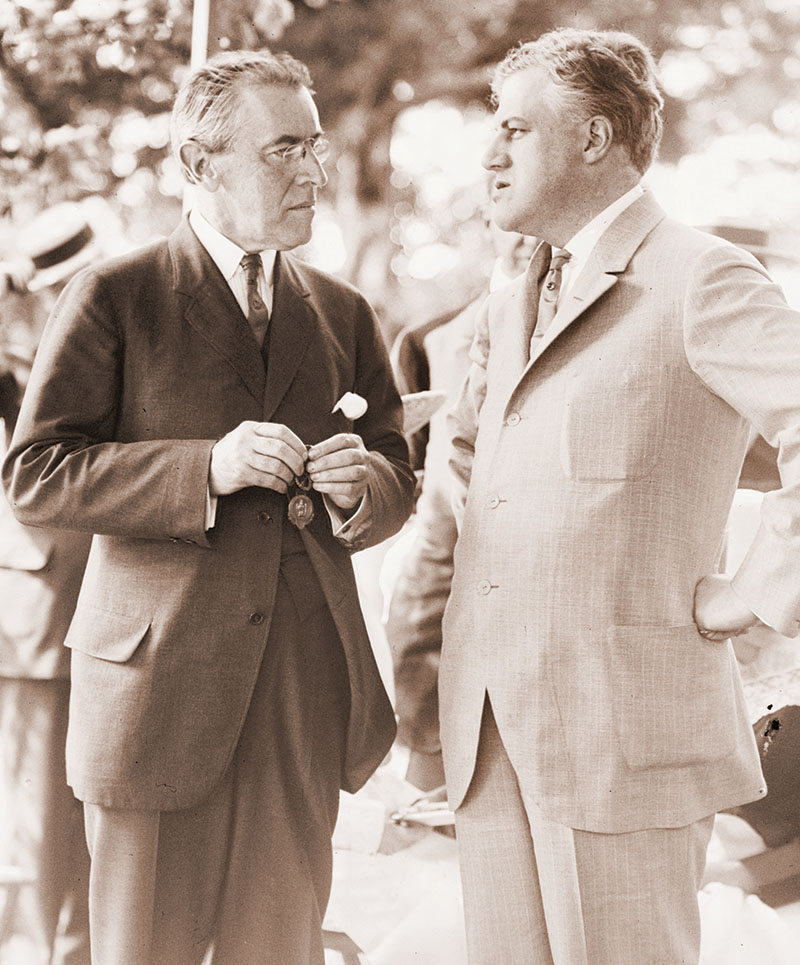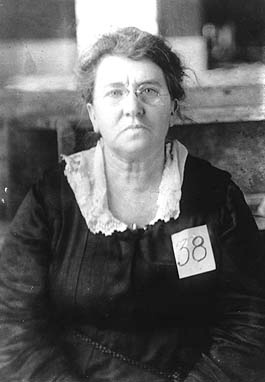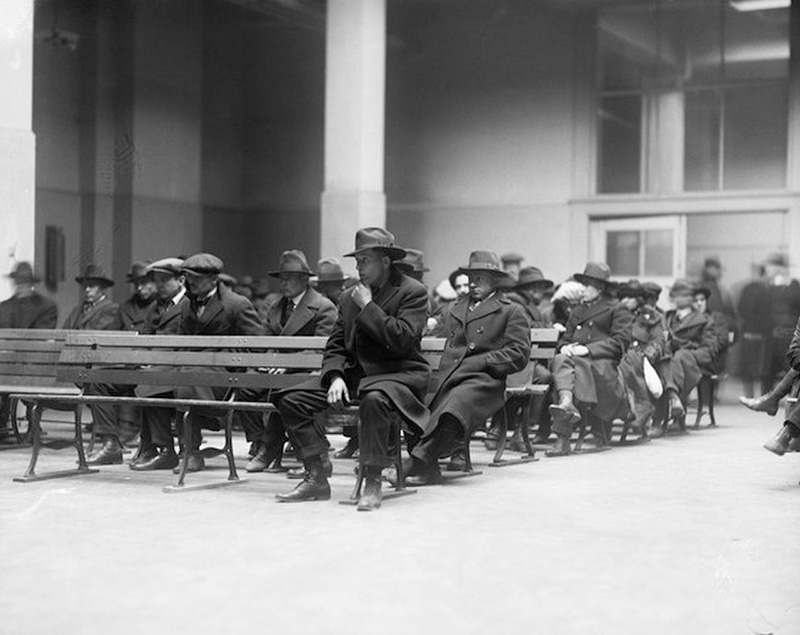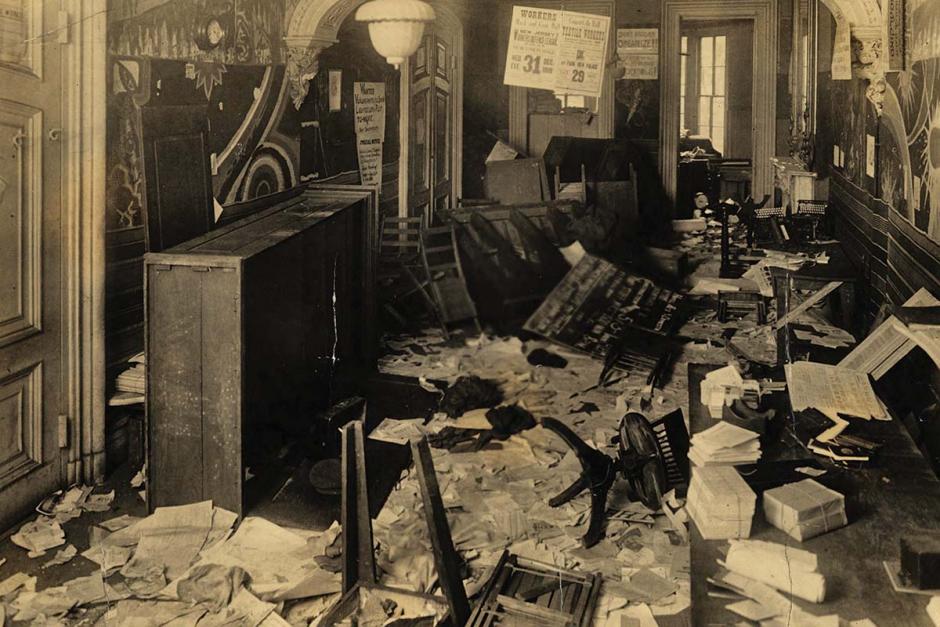The Palmer Raids
Ed Guthero July/August 2022A tale of immigrants, free speech, and mass hysteria in the Land of the Free.
New York City, November 1919
A mathematics class is not typically a setting for subversion. Bespeckled teacher Michael Lavrowsky was busy conducting an algebra lesson for Russian immigrants at Manhattan’s Russian People’s House. Then 50 years old, the studious Lavrowsky had applied for American citizenship, but his hopes and the tranquillity of his classroom were about to be shattered.
Stunned students watched in horror as suddenly armed Department of Justice agents burst into the room. Confronting Lavrowsky, the agents proceeded to mercilessly beat the startled academic. Reeling under the blows, Lavrowsky staggered. The agents flung him down the stairs and resumed their assault. In a bizarre side detail, they had asked the teacher to remove his glasses before pounding him.
There were many people, mostly students, in the Russian People’s House that evening. They were pushed and roughed up, and some were beaten as they were piled into the police wagons waiting at street level. Other students approaching the building were grabbed by agents and beaten in the street. Back inside, federal agents and police commenced to trash the place—smashing furniture and equipment, and scattering paper.
At Department of Justice headquarters agents interrogated those arrested about their connections to the Union of Russian Workers (URW), a labor union that rented space in the Russian People’s House facility. The interrogators discovered that only 39 of the 200 people they had seized were members of the URW.
The union members were detained and the others released, including the battered Lavrowsky, who returned to his Bronx home after midnight. His wife and two children were startled to see him nursing a fractured head, shoulder, and foot.
Across town the majestic Statue of Liberty towered above New York harbor—a watchful symbol of hope to immigrants fleeing war-torn Europe and seeking a new start in America.
What had Lavrowsky, and the 200 others hauled off to the agency’s New York headquarters that infamous night, done to deserve such treatment? And what had triggered law-enforcement personnel to resort to thuggery?
This was the era of America’s first “Red Scare.” The nation was gripped by heightened suspicion of immigrants and labor unions, resulting in waves of raids, arrests, unsettling government surveillance, and deportations. Sometimes just having a foreign accent was enough to get someone arrested. According to Christopher Finan, author of From the Palmer Raids to the Patriot Act: A History of the Fight for Free Speech in America, the crackdown on suspected dissidents meant that “even simple criticism of the government was enough to send you to jail.”1
The architects of these mass raids and arrests were Attorney General A. Mitchell Palmer and his young assistant, J. Edgar Hoover. Palmer had taken leadership of the Department of Justice in early 1919 during a period of daunting challenges for both America and the world. Around the globe, nations were still suffering from the aftershocks of World War I. The recent Bolshevik Revolution in Russia added to the sense of political instability. The world was walking a tightrope of anxiety.
The Buildup
A toxic climate of suspicion and unrest was already growing in America well before Palmer became attorney general. The year 1917 would see accelerated government surveillance and widespread fears that Russia’s revolution would spread to North America.

These fears of a workers’ revolution came at an already tense time for the nation. In April 1917 America had joined World War I on the side of the allies ranged against Kaiser Wilhelm II of Germany. President Woodrow Wilson’s administration showed scant tolerance for any criticism of the government’s wartime policies, and a growing distrust of immigrants added to an atmosphere of uneasiness. Americans were encouraged to monitor and report disloyalty among their neighbors. Vigilante groups formed, targeting German immigrants. Postmaster General Albert S. Burleson moved aggressively to seize masses of anti-war or socialist literature. Members of labor unions, such as the high-profile Industrial Workers of the World—often called the “Wobblies”—were targeted by the government.
During 1917 and 1918 the Wilson administration passed the War Measures Act, the Espionage Act, and the Sedition Act—legislation that enabled sweeping surveillance and prosecution of dissenters or perceived subversives. Under the Espionage Act 2,168 people were indicted and 1,055 were convicted.
Individual freedom of speech also came under heavy assault. Case in point: Rose Pastor Stokes, a socialist, was charged and convicted under the Espionage Act after writing a letter to a Kansas City newspaper editor defending her right to oppose the war. “I am for the people, while the government is for the profiteers,” she wrote.2 Socialist Eugene Debs, who ran for president five times, also spoke out against the war and found himself with a 10-year prison sentence. In addition, devout Quakers and others applying for conscientious-objector status were conscripted regardless and often treated harshly.
Though World War I was soon to end, fear of a Bolshevik-style upheaval and distrust of immigrants remained high in the nation’s consciousness. By 1919, the table was set for new Attorney General A. Mitchell Palmer and the raids that would bear his name.
Crackdown
In retrospect, Palmer seemed an unlikely candidate to lead such a notorious crusade. He was a lawyer and three-term Pennsylvania congressman; a Quaker who supported compassionate causes such as tariff reform, women’s suffrage, and the abolishment of child labor.
By 1912 Palmer was a key player at the Democratic National Convention, and his influence helped Woodrow Wilson secure the party’s presidential nomination. Wilson won the presidency, eventually asking Palmer to become a member of his Cabinet and serve as secretary of war. Palmer, a pacifist, turned down the offer.
In 1917, however, Wilson appointed Palmer to the post of alien property custodian and, with the world engulfed in war, Palmer began a series of search-and-seize raids on property owned by German aliens residing in America. His expansive use of power and dubious investigation methods attracted some criticism.
In the three years following 1917, a deadly nationwide flu pandemic, a string of domestic bombings, and rising labor unrest all served to increase public anxiety. In 1919 alone there were more than 3,600 worker strikes across the nation. This acute tension between industrial workers and employers fueled fears of an imminent Russian-style revolution that would attempt to overthrow the government. According to Finan, employers conflated unionists with Communists, yet these demonstrations “were prompted not by political ideology but by economic issues.” High inflation had accompanied a dramatic rise in unemployment because of the loss of wartime jobs.
Such was the climate when Palmer took over the Department of Justice in 1919. The situation became personal for the new attorney general in early June when an anarchist’s bomb destroyed the front of Palmer’s home. The bomber tripped over a wire and accidentally blew himself up as well. Shortly afterward, two people were killed by a mail bomb sent to a New York legislator. An alert postal clerk later thwarted a mail bomb plot involving 36 explosive packages sent to government and business officials. Newspaper headlines took on an increasingly alarmist tone, and the new attorney general felt pressure to act.
As a congressman, Palmer had a history of supporting civil liberties, and he was a latecomer to the anti-Communist cause. Soon, however, he became a zealous crusader against radicals and “leftist” organizations.
The earlier wartime enactments of the Espionage Act and the Sedition Act combined with congressional internal security appropriations paved the way for Palmer’s agents to commence their series of raids on the offices of Communist, socialist, and anarchist organizations, as well as labor unions. The agents cast their nets wide. Too wide, as unfolding events would soon reveal.
There is a vast difference between criminal acts committed by violent fringe groups and the First Amendment–protected activities of intellectual anarchists, dissenters, workers, or labor advocates. Yet individual rights become vulnerable when public fears fuel stereotyping and generalizations. There was little public opposition when Palmer and Hoover set in motion their wave of mass arrests.
On the same fateful November night that Michael Lavrowsky suffered his beating in Manhattan, Department of Justice agents arrested more than 1,000 people in 11 American cities. In December 249 people, including the charismatic American radical Emma Goldman, were placed on the U.S.S. Buford—a worn-down vessel dubbed the “Soviet Ark”—and unceremoniously deported to Russia.
Shortly before her arrest, Goldman, a longtime U.S. resident, had finished a prison term for opposing the war. At her deportation hearing, she defended her right to free speech, claiming the government was making a terrible mistake by “confusing conformity with security.” Goldman argued that “the free expression of the hopes and aspirations of a people is the greatest and only safety in a sane society.”3
The Peak
The Palmer Raids shifted into an even higher gear, and on January 2, 1920, a wave of arrests targeted more than 30 American cities. Agents smashed down doors and dragged people from their beds. The number of arrests greatly exceeded the number of arrest warrants that had been issued. An estimated 6,000 people were taken into custody in a single day—the largest mass arrest in U.S. history.

Attorney General Palmer heralded the raids as a great success, but questions had begun to arise about the methods and legalities of his crusade. A group of prominent lawyers issued a public denouncement of Palmer and his raids. Assistant Secretary of Labor Louis Freeland Post believed innocent people were being deported, and he ordered an investigation into the January arrests. He found that the raids “failed to support evidence of violent subversion among targeted groups” and he canceled more than 1,500 deportation orders.
Undaunted, Palmer became convinced that a Bolshevik-style revolution was about to take place in America, and that 300,000 Communists were already residing within the country. Palmer, widely believed to have presidential ambitions, was positioning himself as the protector of law and order. He announced that he had uncovered a communist plot to unleash a revolution within the United States, which would occur on May 1, 1920.
As the date approached, public apprehension grew. In New York five judges, known to be socialists, were summarily thrown out of office. Some states called up additional National Guard units in anticipation of impending chaos.
But the first of May came and went. When the Mayday revolution failed to appear, Palmer’s star on the national horizon began to fall rapidly, along with his chances of being nominated as a presidential candidate in the upcoming election. His credibility was shattered.
The raids were halted, but what about the 800 people who had been deported from America’s shores? What about the estimated 10,000 arrests and the violent raids that had marked this moment of national hysteria? What about the numerous immigrant workers and suspected “subversives” who had been detained, kept in custody for months without warrants, charges, or trials?
A Telling Image

There is a photograph, dated January 1920, of a large group of people who had been swept up in the infamous raids of that month. They are seated on long benches at Ellis Island, awaiting the completion of deportation proceedings. At first glance the shadows and the fedora hats of the day obscure the personalities of these men. But what became of them? Who were they? What about their families, jobs, and hopes of a new start in America?
Today, these raids are considered an example of extreme overreach—a blemish on America’s regard for civil liberties and due process. Despite the mass roundups orchestrated by Palmer and Hoover, the individuals behind the June bombings were never found. Of the thousands who were arrested but not deported, 80 percent were released without charges. The Palmer Raids, and the grand scale of the civil rights violations they involved, prompted the formation of the American Civil Liberties Union. In ensuing years Supreme Court decisions placed a burden on governments to prove a “clear and present danger” before infringing on protected speech.
The tragedy of the Palmer Raids reminds us of the immense value to our democracy of First Amendment protections—of speech, press, assembly, and petition. This period in our history also reminds us that in times of national uncertainty, when fear overpowers judgment and minorities are stereotyped and targeted, innocent people will be hurt amid misplaced zeal and confusion. When the hysteria, headlines, and politics fade, the damage to individual lives remains.
Today the lessons of the Palmer Raids should not be forgotten.
1 Quoted in Olivia B. Waxman, “A Century Before Trump’s ICE Raids, the U.S. Government Rounded Up Thousands of Immigrants. Here’s What Happened,” Time, July 18, 2019, retrieved May 5, 2022, https://bit.ly/3MSJk9r.
2 David L. Hudson Jr., “Free Speech in Wartime,” The First Amendment Encyclopedia, retrieved May 5, 2022, https://bit.ly/3w0ai8c
3 Christopher M. Finan, From the Palmer Raids to the Patriot Act: A History of the Fight for Free Speech in America (Boston: Beacon, 2007), p. 5.
Article Author: Ed Guthero
Ed Guthero has had a critically applauded career as a book and periodical designer, artist, and photographer, and a legacy ensured by years as a university lecturer. Here he shows another skill as an author. He writes from Boise, Idaho.
